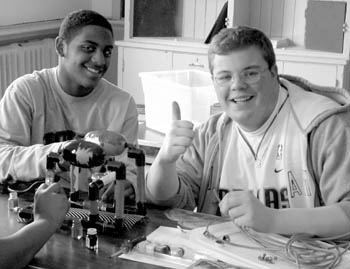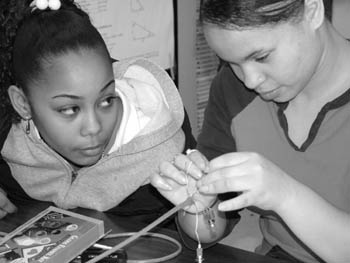
|
Students
Build Sea Perches
Teachers at South Boston's
Odyssey High have found a new way of making sure students stay focused
on Friday afternoons: that's when the students get to build their
Sea Perches. Odyssey High is just one of 18 schools and organizations
participating in a program to teach kids how to build their own remotely
operated underwater robots.
Thus far, 30 teachers and mentors have participated in three-day workshops held at MIT and the Naval Surface Warfare Center's Carderock Division in Maryland. They, in turn, have started Sea Perch programs in Massachusetts, Rhode Island, Virginia, Maryland, Delaware, and New Hampshire. While the robot, made of PVC pipe, can be built by one person working two full days, classroom scenarios differ, with each teacher figuring a pace that works for a particular class or afterschool club. With its themes of marine engineering and ocean exploration, the program teaches students basic skills in ship and submarine design and can easily be turned into a multidisciplinary venture. "The students like building Sea Perches because it's very hands-on, and teachers like it because it engages kids," says Brandy Moran, MIT Sea Grant education coordinator. Moran conducts the training sessions and provides support to teachers. MIT Sea Grant's AUV research engineer Victor Polidoro works with the workshop participants in building the underwater vehicles and is developing low-cost, low-tech sensors and modifications--such as a grabber arm and hydrophone--helping to make the robots into useful tools. At Odyssey High, Robert Bonnano, Bob Healy, and Brian Keefe are teaching 30 ninth grade students in math and physics to build Sea Perches. In building the robots, students learn about weight and buoyancy, as well as how to build a propulsion system and develop a controller. And they learn how to work together.
Marty Rothwell teaches 11th and 12th grade engineering and physics at the Chantilly Academy High School, Fairfax, Va. He says his students have taken to building Sea Perches, in part, because "hands-on [learning] is more effective, challenging and fun." His three students spent three weeks building their robot and then tested it in a local pool with an on-board camera that sent real-time pictures to a TV screen. As for future plans with Sea Perches, Rothwell says, "I would like to create a Sea Perch contest next year with high schools bringing their creations to Carderock for a tournament. It would be a great way to build interest in the Sea Perch program and get students interested in the Navy. As for his students who built the Sea Perch, he says, "They all plan on going into engineering." To see the program's interactive online manual (developed by partners at iMarine, a division of MIT's Ocean Engineering Dept.), or for additional information about the Sea Perch program, please visit http://web.mit.edu/seagrant/k12/SeaPerch/.
|

